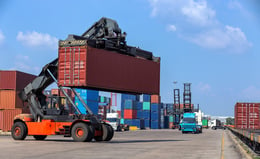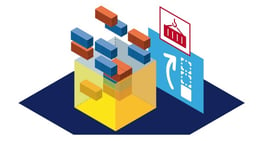Your Small Steps Lead to Big Gains
Keith LaBotz - September 09, 2021

7 Ideas to Maximize the Benefits of Supply Chain Visibility
A virus shifted demand and prompted lockdowns, throttling supply chains. A penstroke shut down an oil pipeline, skyrocketing fuel prices, and a decimal point in the wrong position ships thousands of orders with premium delivery options.
Little things can result in big consequences for a supply chain, particularly choices that affect supply chain visibility. Let’s look at some choices you can make to ensure your company gets the maximum benefit from supply chain visibility.
1. Begin With Definitions
I spend a lot of time on definitions because they determine our perception of things and, ultimately, the choices we make. If you’re looking for a visibility solution, you’ll need to understand it well enough to describe what it looks like for others. You can learn more about this from my post 7 Ways to Improve Supply Chain Visibility.
Ironically, the definition of supply chain visibility is not that clear; it’s an ambiguous term that’s hard to define. When we talk about improving visibility, the goal is optimizing supply chain execution by proactively managing the supply chain. Visibility is really about creating awareness and providing the information necessary to make good decisions. In the supply chain, a good decision is one results in the optimal outcome - optimization.
Optimization requires real-time access to execution-level data and the ability to initiate changes in execution. That’s where efforts should concentrate when improving visibility
2. Take Ownership of Visibility
 The point of taking ownership is to engage the process fully. When you define something, you own it, and that’s why you should define visibility for your company. This means being able to describe how visibility will automate decisions for your supply chain and where it will get the data to make these decisions.
The point of taking ownership is to engage the process fully. When you define something, you own it, and that’s why you should define visibility for your company. This means being able to describe how visibility will automate decisions for your supply chain and where it will get the data to make these decisions.
Visibility serves your company’s decision-making process and objectives, so your definition may differ from mine. I’m not promoting a designer definition of visibility - I’m advocating visibility be understood and defined as relevant to your company’s process.
An effective business process aligns systems and people with business objectives, and visibility is the glue uniting them. The better we understand the process, the more effectively we can utilize the systems and the further we can improve their design. As visibility increases, people and systems synchronize more tightly around the objectives. This can only happen if people understand the business objectives and the process they are part of.
3. Look for Big Gains are in the Little Details
Most logistics exceptions result from overlooking unexpected, small changes during execution. Once visibility provides awareness, problems can be detected and corrected at the earliest possible moment, increasing precision, reliability, and profits. That’s just the shortlist.
My dog Schatzie demonstrated how visibility is like a supply chain watchdog monitoring every detail as it anticipates changes. When things don’t go to his liking, there’s an immediate response. When we apply his antics to software processes, there are two requirements for effective visibility:
1. Monitor execution level details and determines the optimal response and;
2. Control execution level processes for the optimal outcome.
4. Focus on Execution Level Data and Responses
Monitoring and controlling execution involves ground-level intelligence on material handling processes. Technologies like 5G, RFID, beacons, and IoT can provide a real-time view of SKU location, motion, trauma, velocity, temperature, and other attributes of interest. Technologies like these apply to anything moving in the chain, including trailers, containers, and trucks.
Acquiring execution-level data is only the start. Intelligence is needed to automate decision-making for optimization. Solutions like the flexis Transportation Planning and Scheduling and Dynamic Routing can monitor and optimize transportation from the initial planning stages through final delivery. This type of seamless visibility is what you want - intelligence optimizing every point of the fulfillment cycle.
Toss in Big Data and predictive analytics, an item’s location links to surrounding conditions like weather, traffic, or other valuable information to improve decisions. Environmental risks, logistics capacities, and demand planning can come into the picture too. There’s no end to potential gains when an organization monitors and controls execution across a supply chain.
5. Beware of Pipe Dreams
 The scenario described above is possible for a single enterprise controlling its transportation. However, try finding a real-world example of a supply chain with multiple enterprises collaborating in this manner. That’s a pipe dream for right now.
The scenario described above is possible for a single enterprise controlling its transportation. However, try finding a real-world example of a supply chain with multiple enterprises collaborating in this manner. That’s a pipe dream for right now.
The buzz would have you believe otherwise. If you purchase the right visibility platform, the experts will figure out visibility for you. Poof! Instant visibility, optimization, plus you’ll have more free time to spend on other issues. Trust the experts, they understand what’s good for your business, and their solution just happens to be the best one. Where did we hear that before? Oh yeah, I remember. ERP vendors made the same sales pitch thirty years ago.
6. Check Reality Before Proceeding
Something else hasn’t changed over the last 30 years - we need to solve the Supply Chain 4.0 riddle. Obtaining execution level data might provide 50% of visibility’s benefits, and that’s being generous, but visibility is ultimately about optimization, and that requires action.
Obstacles preventing deep collaboration with supply chain partners will eventually disappear, but no one knows how long it will take. As the push for interoperability continues, we can expect sharing of software functions and business rules from a common code base. Collaborative software processes must span multiple enterprises to realize visibility’s full potential. If this is happening somewhere, let me know.
Before making plans to improve visibility, confirm the viability of your vision by talking to vendors and partners in your supply chain.
7. Start With Transportation to Maximize Gains
In the meantime, we should strive for the ideal of end-to-end transparency and address significant gains on the table that can be realized with small visibility improvements. This is particularly true for transportation processes, and there is no better place to begin a visibility initiative.
Transportation planning and scheduling and intelligent routing are great places to start when improving visibility. These can produce large returns without using execution-level data. These are cloud-based solutions that are relatively easy to implement in parallel to existing processes, require few resources, and present minimal risk.
Introducing a visibility platform that’s strong in transportation can deliver execution details from transportation carriers, generating a second wave of savings and efficiency from planning and routing. Sweet deal.
With soaring fuel costs, driver shortages, inflation, and surcharges multiplying like rabbits, optimizing transportation should be prioritized. Given these trends and strong returns, it’s hard to find a reason not to explore transportation optimization.
Conclusion
Hopefully, you’ve learned a few little things that will result in big gains for your supply chain. Technology partners and solutions will fall into place if you have the right approach to supply chain visibility. Think big and start small. I’d be interested in hearing your thoughts on this.
LATEST POSTS
- Understand Circular Economy in The Manufacturing Industry
- How Can Industry 4.0 IT Integration Be Achieved Smoothly?
- The Significance of Order Sequencing in Discrete Manufacturing
- How to improve your Supply Chain Management: The Power of Control Towers
- Optimizing Human Resource Scheduling in Manufacturing: A Technological Approach


